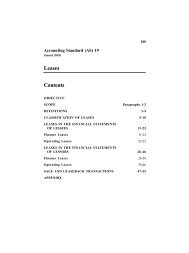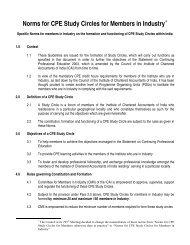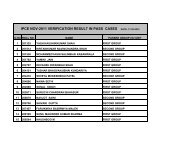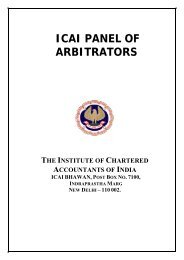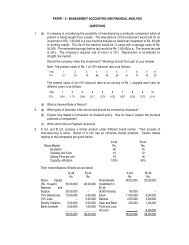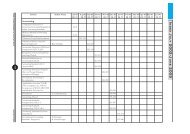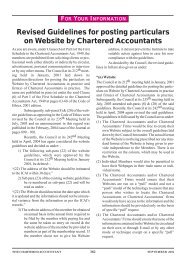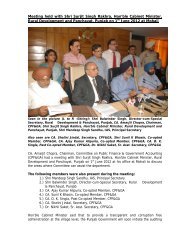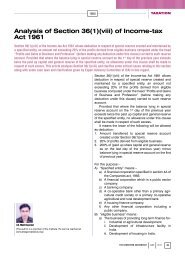The Chartered Accountant
The Chartered Accountant
The Chartered Accountant
You also want an ePaper? Increase the reach of your titles
YUMPU automatically turns print PDFs into web optimized ePapers that Google loves.
ities. <strong>The</strong> expenditure is reduced by<br />
any progress payments received and<br />
grants received in connection with<br />
the asset.<br />
27. <strong>The</strong> activities necessary to prepare<br />
the asset for its intended use or<br />
sale encompass more than the physical<br />
construction of the asset. <strong>The</strong>y<br />
include technical and administrative<br />
work prior to the commencement<br />
of physical construction, such as<br />
the activities associated with obtaining<br />
permits prior to the commencement<br />
of the physical construction.<br />
However, such activities exclude the<br />
holding of an asset when no production<br />
or development that changes the<br />
asset’s condition is taking place. For<br />
example, borrowing costs incurred<br />
while land is under development are<br />
capitalised during the period in which<br />
activities related to the development<br />
are being undertaken. However, borrowing<br />
costs incurred while land acquired<br />
for building purposes is held<br />
without any associated development<br />
activity do not qualify for capitalisation.<br />
Suspension of Capitalisation<br />
28. Capitalisation of borrowing<br />
costs should be suspended during<br />
extended periods in which active<br />
development is interrupted. Such<br />
borrowing costs are expensed.<br />
29. Borrowing costs may be incurred<br />
during an extended period in which<br />
the activities necessary to prepare an<br />
asset for its intended use or sale are<br />
interrupted. Such costs are costs of<br />
holding partially completed assets and<br />
do not qualify for capitalisation. However,<br />
capitalisation of borrowing costs<br />
is not normally suspended during a<br />
period when substantial technical and<br />
administrative work is being carried<br />
out. Capitalisation of borrowing costs<br />
is also not suspended when a temporary<br />
delay is a necessary part of the<br />
process of getting an asset ready for<br />
STANDARDS<br />
its intended use or sale. For example,<br />
capitalisation continues during the<br />
extended period needed for inventories<br />
to mature or the extended period<br />
during which high water levels delay<br />
construction of a bridge, if such high<br />
water levels are common during the<br />
construction period in the geographic<br />
region involved.<br />
Cessation of Capitalisation<br />
30. Capitalisation of borrowing<br />
costs should cease when substantially<br />
all the activities necessary<br />
to prepare the qualifying asset for<br />
its intended use or sale are complete.<br />
31. An asset is normally ready for its<br />
intended use or sale when the physical<br />
construction of the asset is complete<br />
even though routine administrative<br />
work might still continue.<br />
If minor modifications, such as the<br />
decoration of a property to the purchaser’s<br />
or user’s specification, are<br />
all that is outstanding, this indicates<br />
that substantially all the activities are<br />
complete.<br />
32. When the construction of a<br />
qualifying asset is completed in<br />
parts and a completed part is<br />
capable of being used while construction<br />
continues for the other<br />
parts, capitalisation of borrowing<br />
costs in relation to a part should<br />
cease when substantially all the<br />
activities necessary to prepare that<br />
part for its intended use or sale are<br />
completed.<br />
33. Example of a qualifying asset for<br />
which each part is capable of being<br />
used while construction continues<br />
for the other parts is an office development<br />
comprising several buildings,<br />
each of which can be used individually.<br />
34. Examples of qualifying assets<br />
that need to be completed before any<br />
part can be used include an operating<br />
room in a hospital when all construction<br />
must be complete before the<br />
room may be used; a sewage treatment<br />
plant where several processes<br />
are carried out in sequence at different<br />
parts of the plant; and a bridge<br />
forming part of a highway. In such<br />
cases, capitalisation of borrowing<br />
costs should be continued.<br />
Disclosure<br />
35. <strong>The</strong> financial statements<br />
should disclose:<br />
(a) the accounting policy adopted<br />
for borrowing costs<br />
incurred specifically for<br />
the acquisition , construction<br />
or production of a<br />
qualifying asset; and<br />
(b) the amount of borrowing<br />
costs capitalised during the<br />
period.<br />
Illustration 1<br />
Appendix A<br />
Note: This appendix is illustrative<br />
only and does not form part of the<br />
Accounting Standard. Its purpose is<br />
to assist in clarifying the meaning of<br />
the paragraph 4 (e) of the standard.<br />
Facts:<br />
Local Body XYZ has taken a loan of<br />
USD 10,000 on April 1, 20X3, for a<br />
specific project at an interest rate of<br />
5% p.a., payable annually. On April 1,<br />
20X3, the exchange rate between the<br />
currencies was Rs. 45 per USD. <strong>The</strong><br />
exchange rate, as at March 31, 20X4,<br />
is Rs. 48 per USD. <strong>The</strong> corresponding<br />
amount could have been borrowed<br />
by Local Body XYZ in local currency<br />
at an interest rate of 11 per cent per<br />
annum as on April 1, 20X3.<br />
<strong>The</strong> following computation would<br />
be made to determine the amount<br />
of borrowing costs for the purposes<br />
of paragraph 4(e) of this Accounting<br />
THE CHARTERED ACCOUNTANT 1083 DECEMBER 2008



